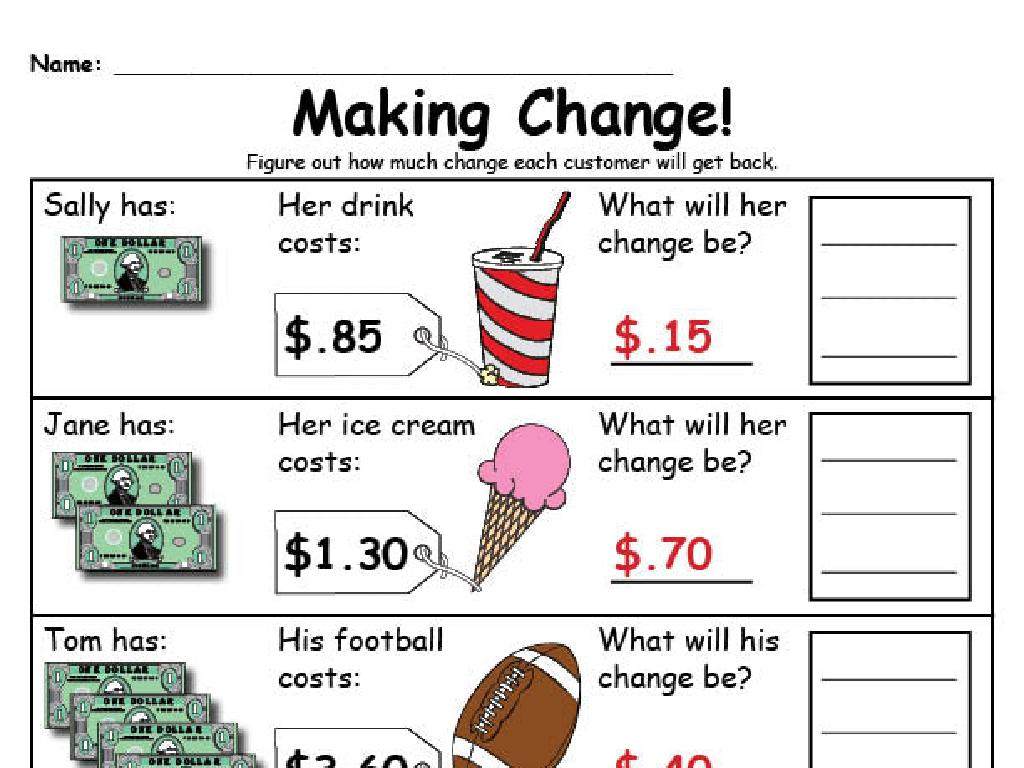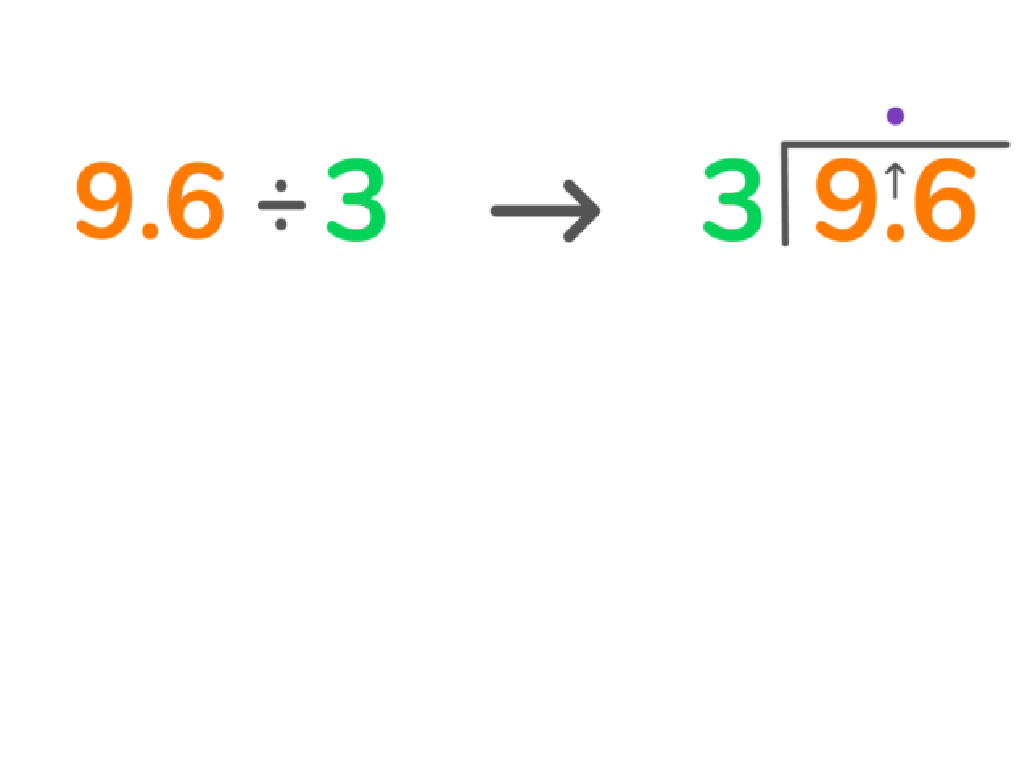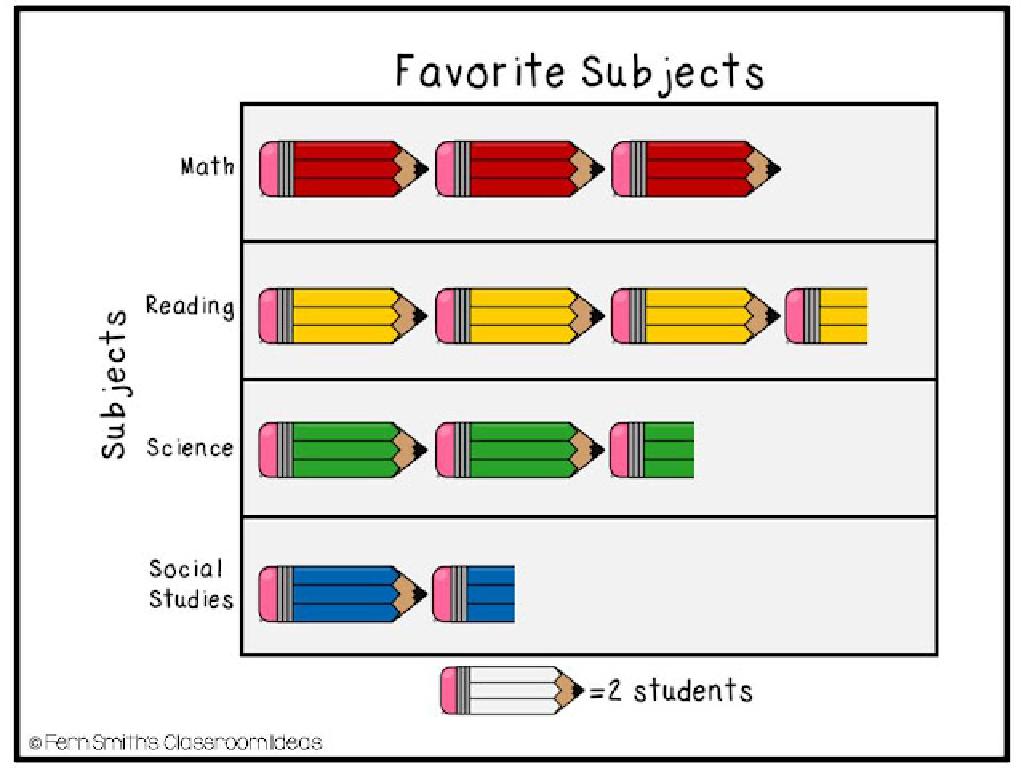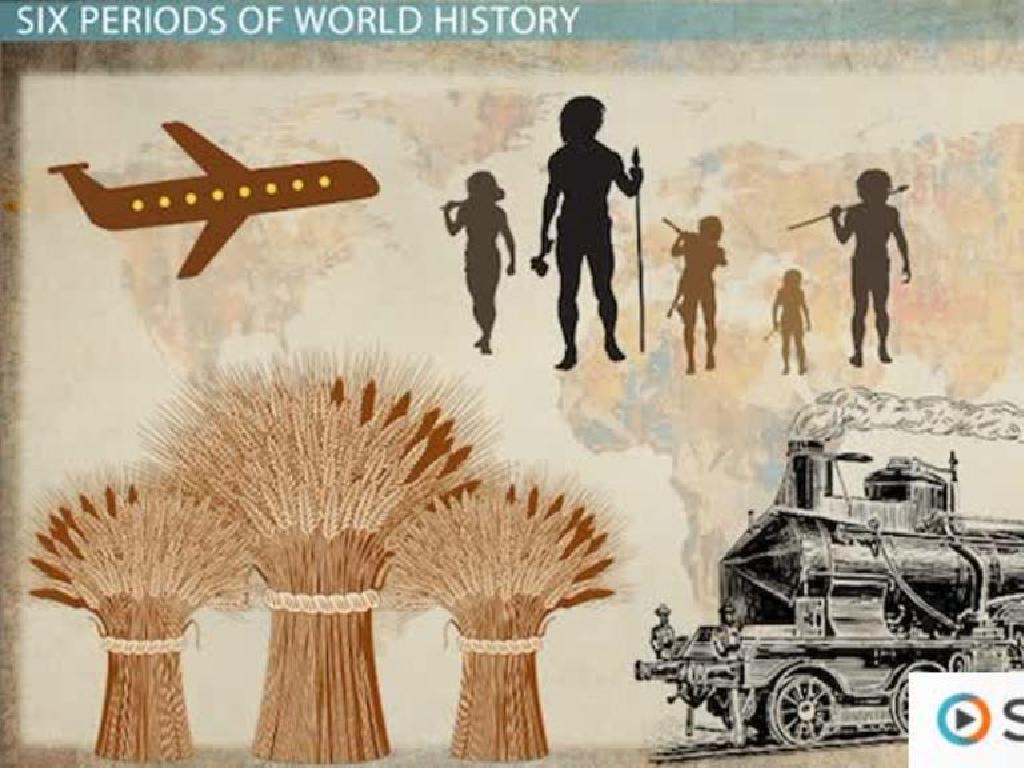Compare Properties Of Objects
Subject: Science
Grade: Second grade
Topic: Materials
Please LOG IN to download the presentation. Access is available to registered users only.
View More Content
Exploring Materials and Their Properties
– Learn about different materials
– Compare material properties
– Hardness, flexibility, color, and use
– Identify objects and their materials
– Examples: Cotton shirt, plastic toy
– Engage in material discovery
– Feel and look at objects around you
|
This slide introduces the concept of materials science to second graders. Start by explaining that everything around us is made from different materials like metal, plastic, wood, and fabric. Discuss the importance of properties such as hardness, flexibility, and color in determining the use of a material. Encourage students to think of objects they use daily and what materials they are made from. This will help them relate to the topic and understand the diversity of materials in their environment. Plan an interactive activity where students can touch and feel different objects to guess the material. This tactile approach will enhance their learning experience and make the concept of material properties more tangible.
Exploring Materials and Their Properties
– Understanding materials
– Materials are substances objects are made from.
– Examples of common materials
– Metal, wood, plastic, glass, and fabric are everywhere.
– Properties of materials
– Properties are qualities like strength, flexibility, and texture.
– Comparing material properties
– Why is a window made of glass and not wood?
|
This slide introduces the concept of materials to second-grade students, explaining that everything around them is made from some type of material. Highlight common materials such as metal, wood, plastic, glass, and fabric, and discuss their presence in everyday objects. Explain that materials have different properties, which are the characteristics that help us decide which material to use for a specific purpose. For example, glass is used for windows because it is transparent and lets light through, whereas wood is used for furniture because it is sturdy and can support weight. Encourage students to think about the objects they use daily and what materials they are made from. This will set the foundation for understanding why certain materials are chosen for specific objects based on their properties.
Exploring Material Properties
– Properties describe materials
– How materials look, feel, and act
– Examples: hard, soft, stretchy
– Rubber is stretchy, clay is soft
– More examples: stiff, heavy, light
– Wood is stiff, feathers are light
– Let’s find examples together!
|
This slide introduces the concept of material properties to second-grade students. Begin by explaining that properties are characteristics that help us describe and identify different materials. Use tangible examples like a rubber band being stretchy or a pillow being soft to illustrate the point. Encourage the students to touch and feel different objects to understand these properties better. For the interactive part of the lesson, ask the students to bring an object from home and describe its properties using the vocabulary learned. This will help them apply their knowledge and understand the properties of materials in a practical context.
Comparing Hard and Soft Materials
– Hard materials resist squishing
– Like rocks, they don’t change shape easily
– Soft materials can be squished
– Like sponges, they’re easy to squeeze
– Examples of hard and soft items
– Think of other examples around us
– Class activity: Identify hard and soft
|
This slide introduces the concept of comparing the properties of hard and soft materials. Begin by explaining that hard materials, such as rocks, do not change shape easily when force is applied. In contrast, soft materials, like sponges, can be squished and squeezed. Encourage the students to think of more examples of hard and soft objects they encounter in their daily lives. For the class activity, have students bring or identify items from around the classroom that are hard or soft and discuss why they fit into each category. This will help them understand the concept of hardness and softness in materials through tangible examples.
Transparent or Opaque?
– What are transparent materials?
– Materials you can see through, like glass
– What are opaque materials?
– Materials you can’t see through, like wood
– Classroom object hunt
– Discuss our findings
|
This slide introduces the concept of transparency and opacity in materials. Transparent materials, such as clear glass windows, allow light to pass through, making objects on the other side visible. Opaque materials, like a wooden door, block light and prevent the visibility of objects behind them. Encourage the students to look around the classroom to find examples of both transparent and opaque objects. After the hunt, gather the students to discuss what they found and why those objects are transparent or opaque. This activity will help them understand the properties of materials in a practical and engaging way.
Heavy or Light?: Exploring Object Weight
– What makes an object heavy?
– Heavy objects are harder to lift, e.g., a big rock
– What makes an object light?
– Light objects are easier to lift, e.g., a feather
– Weighing classroom objects
– Use scales to measure how heavy or light items are
– Discovering heavy and light
|
This slide introduces the concept of weight and how it can be observed in everyday objects. Start by explaining that weight is a property that can be felt when trying to lift or move something. Heavy objects, like a big rock, require more effort to lift, while light objects, like a feather, require very little effort. Encourage students to think about objects they believe are heavy or light and why. During the activity, students will use scales to weigh various objects found in the classroom to determine if they are heavy or light. This hands-on experience will help solidify their understanding of the concept of weight. Prepare a set of diverse objects for the activity and ensure that each student has the opportunity to use the scale and record their observations.
Class Activity: Material Hunt
– Let’s go on a material hunt!
– Find objects and identify materials
– Is it wood, plastic, metal, or fabric?
– Discuss material choices
– Why is a window made of glass and not wood?
– Think about material properties
– How do the properties like hardness or flexibility affect the use?
|
This activity is designed to help students explore and understand the different materials objects are made from. Encourage the children to look around the classroom and select various items, identifying whether they are made of wood, plastic, metal, fabric, or other materials. Facilitate a discussion on why certain materials are chosen for specific objects, such as the transparency of glass for windows or the strength of metal for a chair leg. This will help them grasp the concept of material properties and their applications. Possible activities include: 1) Sorting classroom objects based on the material, 2) Comparing two objects made from different materials and discussing their differences, 3) A ‘guess the material’ game with blindfolds, 4) Creating a chart of objects and their materials, 5) Drawing objects and labeling the materials they’re made from.
Group Discussion: Material Properties
– Share your objects with the class
– Discuss the material properties
– Is it hard or soft? Heavy or light? Smooth or rough?
– Why was it made from this material?
– Consider the object’s use and why the material is a good fit
– Think about material suitability
– Does the material make the object function better?
|
This slide is meant to facilitate a group discussion among second-grade students about the properties of materials and their uses. Students should bring an object from home and share it with the class, discussing its material properties such as hardness, weight, texture, and more. Encourage them to think critically about why certain materials are used for specific objects, considering factors like durability, weight, and cost. For example, a water bottle is made of plastic because it’s lightweight and durable, while a window is made of glass to be transparent and hard. The teacher should guide the discussion, ensuring each student has a chance to participate and reflect on the importance of material properties in everyday objects.
Wrapping Up: Material Properties
– Congrats on today’s material hunt!
– Learned comparing material properties
– Hardness, flexibility, color, and more
– Properties guide material usage
– Example: Using metal for a spoon because it’s strong
– Think about best material for objects
|
Today’s class was a success, and the students did a fantastic job on their material hunt activity. They’ve learned how to observe and compare different properties of materials such as hardness, flexibility, and color. It’s important for them to understand that these properties determine the suitability of materials for various purposes. For instance, we use metal to make spoons because it is strong and durable. Encourage the students to look around their homes and identify why certain materials are used for specific objects. This will help reinforce today’s lesson and give them a practical understanding of material properties.
Hands-On Activity: Build & Compare
– Build using various materials
– Compare material effectiveness
– How did each material handle the task?
– Discuss the best material choice
– Share with classmates and listen to their choices
– Explain your reasons
– Think about strength, flexibility, and ease of use
|
This slide introduces a hands-on class activity aimed at helping students understand the properties of different materials through direct experience. Students are encouraged to use a variety of materials to create a simple object, such as a bridge or a tower. They should then assess the suitability of each material for the task, considering factors like strength, flexibility, and ease of use. After building, students will engage in a discussion with their peers to determine which material was the most effective and why. This activity fosters critical thinking and collaborative learning. For the teacher: Prepare a selection of materials for the students to use, ensure safety during the activity, and facilitate the discussion afterwards. Possible materials include straws, popsicle sticks, clay, and paper. Have students consider the properties of each material as they build and compare their creations.





